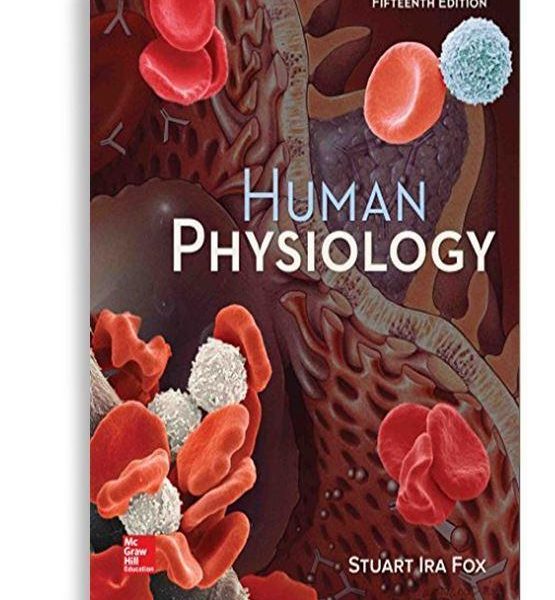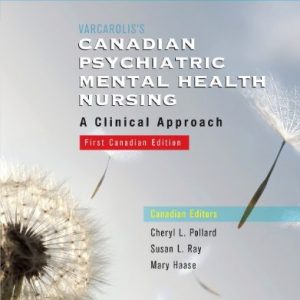Test Bank For Human Physiology 15th Edition By Stuart Fox

Product details:
- ISBN-10 : 1259864626
- ISBN-13 : 978-1259864629
- Author: Stuart Fox
#1 selling text with great explanations and just enough anatomy!Clear explanations and a solid learning framework have been market tested and refined. Fox helps students master the fundamentals by providing appropriate anatomical detail.Human Physiology, Fifteenth Edition, is intended for the one-semester Human Physiology course often taken by allied health and biology students. The beginning chapters introduce basic chemical and biological concepts to provide students with the framework they need to comprehend physiological principles. The chapters that follow promote conceptual understanding rather than rote memorization of facts. Health applications are included throughout the book to heighten interest, deepen understanding of physiological concepts, and help students relate the material to their individual career goals. Every effort has been made to help students integrate related concepts and understand the relationships between anatomical structures and their functions.Users who purchase Connect A&P receive access to the following digital resources•LearnSmart Prep•SmartBook•Tegrity (Lecture Capture)•Ph.i.L.S. (Physiology Interactive Laboratory Simulations)•Anatomy & Physiology Revealed (Cadaver Version)
Table contents:
- 1 The Study of Body Function
- 1.1 Introduction to Physiology
- Scientific Method
- 1.2 Homeostasis and Feedback Control
- History of Physiology
- Negative Feedback Loops
- Positive Feedback
- Neural and Endocrine Regulation
- Feedback Control of Hormone Secretion
- 1.3 The Primary Tissues
- Muscle Tissue
- Nerve Tissue
- Epithelial Tissue
- Connective Tissue
- 1.4 Organs and Systems
- An Example of an Organ: The Skin
- Systems
- Body-Fluid Compartments
- Summary
- Review Activities
- 2 Chemical Composition of the Body
- 2.1 Atoms, Ions, and Chemical Bonds
- Atoms
- Chemical Bonds, Molecules, and Ionic Compounds
- Acids, Bases, and the pH Scale
- Organic Molecules
- 2.2 Carbohydrates and Lipids
- Carbohydrates
- Lipids
- 2.3 Proteins
- Structure of Proteins
- Functions of Proteins
- 2.4 Nucleic Acids
- Deoxyribonucleic Acid
- Ribonucleic Acid
- Summary
- Review Activities
- 3 Cell Structure and Genetic Control
- 3.1 Plasma Membrane and Associated Structures
- Structure of the Plasma Membrane
- Phagocytosis
- Endocytosis
- Exocytosis
- Cilia and Flagella
- Microvilli
- 3.2 Cytoplasm and Its Organelles
- Cytoplasm and Cytoskeleton
- Lysosomes
- Peroxisomes
- Mitochondria
- Ribosomes
- Endoplasmic Reticulum
- Golgi Complex
- 3.3 Cell Nucleus and Gene Expression
- Genome and Proteome
- Chromatin
- RNA Synthesis
- RNA Interference
- 3.4 Protein Synthesis and Secretion
- Transfer RNA
- Formation of a Polypeptide
- Functions of the Endoplasmic Reticulum and Golgi Complex
- Protein Degradation
- 3.5 Dna Synthesis and Cell Division
- DNA Replication
- The Cell Cycle
- Mitosis
- Meiosis
- Epigenetic Inheritance
- Interactions
- Summary
- Review Activities
- 4 Enzymes and Energy
- 4.1 Enzymes as Catalysts
- Mechanism of Enzyme Action
- Naming of Enzymes
- 4.2 Control of Enzyme Activity
- Effects of Temperature and pH
- Cofactors and Coenzymes
- Enzyme Activation
- Substrate Concentration and Reversible Reactions
- Metabolic Pathways
- 4.3 Bioenergetics
- Endergonic and Exergonic Reactions
- Coupled Reactions: ATP
- Coupled Reactions: Oxidation-Reduction
- Summary
- Review Activities
- 5 Cell Respiration and Metabolism
- 5.1 Glycolysis and the Lactic Acid Pathway
- Glycolysis
- Lactic Acid Pathway
- 5.2 Aerobic Respiration
- Citric Acid Cycle
- Electron Transport and Oxidative Phosphorylation
- Coupling of Electron Transport to ATP Production
- ATP Balance Sheet
- 5.3 Interconversion of Glucose, Lactic Acid, and Glycogen
- Glycogenesis and Glycogenolysis
- Cori Cycle
- 5.4 Metabolism of Lipids and Proteins
- Lipid Metabolism
- Amino Acid Metabolism
- Uses of Different Energy Sources
- Interactions
- Summary
- Review Activities
- 6 Interactions Between Cells and the Extracellular Environment
- 6.1 Extracellular Environment
- Body Fluids
- Extracellular Matrix
- Categories of Transport Across the Plasma Membrane
- 6.2 Diffusion and Osmosis
- Diffusion Through the Plasma Membrane
- Rate of Diffusion
- Osmosis
- Regulation of Blood Osmolality
- 6.3 Carrier-Mediated Transport
- Facilitated Diffusion
- Active Transport
- Bulk Transport
- 6.4 The Membrane Potential
- Equilibrium Potentials
- Resting Membrane Potential
- 6.5 Cell Signaling
- Second Messengers
- G-Proteins
- Interactions
- Summary
- Review Activities
- 7 The Nervous System
- 7.1 Neurons and Supporting Cells
- Neurons
- Classification of Neurons and Nerves
- Neuroglia
- Neurilemma and Myelin Sheath
- Functions of Astrocytes
- 7.2 Electrical Activity In Axons
- Ion Gating in Axons
- Action Potentials
- Conduction of Nerve Impulses
- 7.3 The Synapse
- Electrical Synapses: Gap Junctions
- Chemical Synapses
- 7.4 Acetylcholine as a Neurotransmitter
- Chemically Regulated Channels
- Acetylcholinesterase (AChE)
- Acetylcholine in the PNS
- Acetylcholine in the CNS
- 7.5 Monoamines as Neurotransmitters
- Serotonin as a Neurotransmitter
- Dopamine as a Neurotransmitter
- Norepinephrine as a Neurotransmitter
- 7.6 Other Neurotransmitters
- Amino Acids as Neurotransmitters
- Polypeptides as Neurotransmitters
- Endocannabinoids as Neurotransmitters
- Gases as Neurotransmitters
- ATP and Adenosine as Neurotransmitters
- 7.7 Synaptic Integration
- Synaptic Plasticity
- Synaptic Inhibition
- Summary
- Review Activities
- 8 The Central Nervous System
- 8.1 Structural Organization of the Brain
- 8.2 Cerebrum
- Cerebral Cortex
- Basal Nuclei
- Cerebral Lateralization
- Language
- Limbic System and Emotion
- Memory
- Emotion and Memory
- 8.3 Diencephalon
- Thalamus and Epithalamus
- Hypothalamus and Pituitary Gland
- 8.4 Midbrain and Hindbrain
- Midbrain
- Hindbrain
- Reticular Activating System in Sleep and Arousal
- 8.5 Spinal Cord Tracts
- Ascending Tracts
- Descending Tracts
- 8.6 Cranial and Spinal Nerves
- Cranial Nerves
- Spinal Nerves
- Summary
- Review Activities
- 9 The Autonomic Nervous System
- 9.1 Neural Control of Involuntary Effectors
- Autonomic Neurons
- Visceral Effector Organs
- 9.2 Divisions of the Autonomic Nervous System
- Sympathetic Division
- Parasympathetic Division
- 9.3 Functions of the Autonomic Nervous System
- Adrenergic and Cholinergic Synaptic Transmission
- Responses to Adrenergic Stimulation
- Responses to Cholinergic Stimulation
- Other Autonomic Neurotransmitters
- Organs with Dual Innervation
- Organs Without Dual Innervation
- Control of the Autonomic Nervous System by Higher Brain Centers
- Interactions
- Summary
- Review Activities
- 10 Sensory Physiology
- 10.1 Characteristics of Sensory Receptors
- Categories of Sensory Receptors
- Law of Specific Nerve Energies
- Generator (Receptor) Potential
- 10.2 Cutaneous Sensations
- Neural Pathways for Somatesthetic Sensations
- Receptive Fields and Sensory Acuity
- Lateral Inhibition
- 10.3 Taste and Smell
- Taste
- Smell
- 10.4 Vestibular Apparatus and Equilibrium
- Sensory Hair Cells of the Vestibular Apparatus
- Utricle and Saccule
- Semicircular Canals
- 10.5 The Ears and Hearing
- Outer Ear
- Middle Ear
- Cochlea
- Spiral Organ (Organ of Corti)
- 10.6 The Eyes and Vision
- Refraction
- Accommodation
- Visual Acuity
- 10.7 Retina
- Effect of Light on the Rods
- Electrical Activity of Retinal Cells
- Cones and Color Vision
- Visual Acuity and Sensitivity
- Neural Pathways from the Retina
- 10.8 Neural Processing of Visual Information
- Ganglion Cell Receptive Fields
- Lateral Geniculate Nuclei
- Cerebral Cortex
- Interactions
- Summary
- Review Activities
- 11 Endocrine Glands
- 11.1 Endocrine Glands and Hormones
- Common Aspects of Neural and Endocrine Regulation
- Chemical Classification of Hormones
- Prohormones and Prehormones
- Hormone Interactions
- Effects of Hormone Concentrations on Tissue Response
- 11.2 Mechanisms of Hormone Action
- Hormones That Bind to Nuclear Receptor Proteins
- Hormones That Use Second Messengers
- 11.3 Pituitary Gland
- Pituitary Hormones
- Hypothalamic Control of the Posterior Pituitary
- Hypothalamic Control of the Anterior Pituitary
- Feedback Control of the Anterior Pituitary
- Higher Brain Function and Pituitary Secretion
- 11.4 Adrenal Glands
- Functions of the Adrenal Cortex
- Functions of the Adrenal Medulla
- Stress and the Adrenal Gland
- 11.5 Thyroid and Parathyroid Glands
- Production and Action of Thyroid Hormones
- Parathyroid Glands
- 11.6 Pancreas and Other Endocrine Glands
- Pancreatic Islets
- Pineal Gland
- Gastrointestinal Tract
- Gonads and Placenta
- 11.7 Paracrine and Autocrine Regulation
- Examples of Paracrine and Autocrine Regulation
- Prostaglandins
- Interactions
- Summary
- Review Activities
- 12 Muscle
- 12.1 Skeletal Muscles
- Structure of Skeletal Muscles
- Motor End Plates and Motor Units
- 12.2 Mechanisms of Contraction
- Sliding Filament Theory of Contraction
- Regulation of Contraction
- 12.3 Contractions of Skeletal Muscles
- Twitch, Summation, and Tetanus
- Types of Muscle Contractions
- Series-Elastic Component
- Length-Tension Relationship
- 12.4 Energy Requirements of Skeletal Muscles
- Metabolism of Skeletal Muscles
- Slow- and Fast-Twitch Fibers
- Muscle Fatigue
- Adaptations of Muscles to Exercise Training
- Muscle Damage and Repair
- 12.5 Neural Control of Skeletal Muscles
- Muscle Spindle
- Alpha and Gamma Motor Neurons
- Coactivation of Alpha and Gamma Motor Neurons
- Skeletal Muscle Reflexes
- Upper Motor Neuron Control of Skeletal Muscles
- 12.6 Cardiac and Smooth Muscles
- Cardiac Muscle
- Smooth Muscle
- Interactions
- Summary
- Review Activities
- 13 Blood, Heart, and Circulation
- 13.1 Functions and Components of the Circulatory System
- Functions of the Circulatory System
- Major Components of the Circulatory System
- 13.2 Composition of the Blood
- Blood Plasma
- The Formed Elements of Blood
- Hematopoiesis
- Red Blood Cell Antigens and Blood Typing
- Blood Clotting
- Dissolution of Clots
- 13.3 Structure of the Heart
- Pulmonary and Systemic Circulations
- Atrioventricular and Semilunar Valves
- Heart Sounds
- 13.4 Cardiac Cycle
- Pressure Changes During the Cardiac Cycle
- 13.5 Electrical Activity of the Heart and the Electrocardiogram
- Electrical Activity of the Heart
- The Electrocardiogram
- 13.6 Blood Vessels
- Arteries
- Capillaries
- Veins
- 13.7 Atherosclerosis and Cardiac Arrhythmias
- Atherosclerosis
- Arrhythmias Detected by the Electrocardiograph
- 13.8 Lymphatic System
- Summary
- Review Activities
- 14 Cardiac Output, Blood Flow, and Blood Pressure
- 14.1 Cardiac Output
- Regulation of Cardiac Rate
- Regulation of Stroke Volume
- Venous Return
- 14.2 Blood Volume
- Exchange of Fluid Between Capillaries and Tissues
- Regulation of Blood Volume by the Kidneys
- 14.3 Vascular Resistance to Blood Flow
- Physical Laws Describing Blood Flow
- Extrinsic Regulation of Blood Flow
- Paracrine Regulation of Blood Flow
- Intrinsic Regulation of Blood Flow
- 14.4 Blood Flow to the Heart and Skeletal Muscles
- Aerobic Requirements of the Heart
- Regulation of Coronary Blood Flow
- Regulation of Blood Flow Through Skeletal Muscles
- Circulatory Changes During Exercise
- 14.5 Blood Flow to the Brain and Skin
- Cerebral Circulation
- Cutaneous Blood Flow
- 14.6 Blood Pressure
- Baroreceptor Reflex
- Atrial Stretch Reflexes
- Measurement of Blood Pressure
- Pulse Pressure and Mean Arterial Pressure
- 14.7 Hypertension, Shock, and Congestive Heart Failure
- Hypertension
- Circulatory Shock
- Congestive Heart Failure
- Interactions
- Summary
- Review Activities
- 15 The Immune System
- 15.1 Defense Mechanisms
- Innate (Nonspecific) Immunity
- Adaptive (Specific) Immunity
- Lymphocytes and Lymphoid Organs
- Local Inflammation
- 15.2 Functions of B Lymphocytes
- Antibodies
- The Complement System
- 15.3 Functions of T Lymphocytes
- Cytotoxic, Helper, and Regulatory T Lymphocytes
- Interactions Between Antigen-Presenting Cells and T Lymphocytes
- 15.4 Active and Passive Immunity
- Active Immunity and the Clonal Selection Theory
- Immunological Tolerance
- Passive Immunity
- 15.5 Tumor Immunology
- Innate Lymphoid Cells
- Effects of Aging and Stress
- 15.6 Diseases Caused by the Immune System
- Autoimmunity
- Immune Complex Diseases
- Allergy
- Interactions
- Summary
- Review Activities
- 16 Respiratory Physiology
- 16.1 The Respiratory System
- Structure of the Respiratory System
- Thoracic Cavity
- 16.2 Physical Aspects of Ventilation
- Intrapulmonary and Intrapleural Pressures
- Physical Properties of the Lungs
- Surfactant and Respiratory Distress Syndrome
- 16.3 Mechanics of Breathing
- Inspiration and Expiration
- Pulmonary Function Tests
- Pulmonary Disorders
- 16.4 Gas Exchange in the Lungs
- Calculation of PO2
- Partial Pressures of Gases in Blood
- Significance of Blood PO2 and PCO2 Measurements
- Pulmonary Circulation and Ventilation/Perfusion Ratios
- Disorders Caused by High Partial Pressures of Gases
- 16.5 Regulation of Breathing
- Brain Stem Respiratory Centers
- Effects of Blood PCO2 and pH on Ventilation
- Effects of Blood PO2 on Ventilation
- Effects of Pulmonary Receptors on Ventilation
- 16.6 Hemoglobin and Oxygen Transport
- Hemoglobin
- The Oxyhemoglobin Dissociation Curve
- Effect of pH and Temperature on Oxygen Transport
- Effect of 2,3-DPG on Oxygen Transport
- Inherited Defects in Hemoglobin Structure and Function
- Muscle Myoglobin
- 16.7 Carbon Dioxide Transport
- The Chloride Shift
- The Reverse Chloride Shift
- 16.8 Acid-Base Balance of the Blood
- Principles of Acid-Base Balance
- Ventilation and Acid-Base Balance
- 16.9 Effect of Exercise and High Altitude on Respiratory Function
- Ventilation During Exercise
- Acclimatization to High Altitude
- Interactions
- Summary
- Review Activities
- 17 Physiology of the Kidneys
- 17.1 Structure and Function of the Kidneys
- Gross Structure of the Urinary System
- Control of Micturition
- Microscopic Structure of the Kidney
- 17.2 Glomerular Filtration
- Glomerular Ultrafiltrate
- Regulation of Glomerular Filtration Rate
- 17.3 Reabsorption of Salt and Water
- Reabsorption in the Proximal Tubule
- The Countercurrent Multiplier System
- Collecting Duct: Effect of Antidiuretic Hormone (ADH)
- 17.4 Renal Plasma Clearance
- Transport Process Affecting Renal Clearance
- Renal Clearance of Inulin: Measurement of GFR
- Renal Clearance Measurements
- Reabsorption of Glucose
- 17.5 Renal Control of Electrolyte and Acid-Base Balance
- Role of Aldosterone in Na+/K+ Balance
- Control of Aldosterone Secretion
- Natriuretic Peptides
- Relationship Between Na+, K+, and H+
- Renal Acid-Base Regulation
- 17.6 Diuretics and Renal Function Tests
- Use of Diuretics
- Renal Function Tests and Kidney Disease
- Interactions
- Summary
- Review Activities
- 18 The Digestive System
- 18.1 Introduction to the Digestive System
- Layers of the Alimentary Tract
- Regulation of the Alimentary Tract
- 18.2 From Mouth to Stomach
- Esophagus
- Stomach
- Pepsin and Hydrochloric Acid Secretion
- 18.3 Small Intestine
- Villi and Microvilli
- Intestinal Enzymes
- Intestinal Contractions and Motility
- 18.4 Large Intestine
- Intestinal Microbiota
- Fluid and Electrolyte Absorption in the Intestine
- Defecation
- 18.5 Liver, Gallbladder, and Pancreas
- Structure of the Liver
- Functions of the Liver
- Gallbladder
- Pancreas
- 18.6 Regulation of the Digestive System
- Regulation of Gastric Function
- Regulation of Intestinal Function
- Regulation of Pancreatic Juice and Bile Secretion
- Trophic Effects of Gastrointestinal Hormones
- 18.7 Digestion and Absorption of Food
- Digestion and Absorption of Carbohydrates
- Digestion and Absorption of Proteins
- Digestion and Absorption of Lipids
- Interactions
- Summary
- Review Activities
- 19 Regulation of Metabolism
- 19.1 Nutritional Requirements
- Metabolic Rate and Caloric Requirements
- Anabolic Requirements
- Vitamins and Minerals
- Free Radicals and Antioxidants
- 19.2 Regulation of Energy Metabolism
- Regulatory Functions of Adipose Tissue
- Regulation of Hunger and Metabolic Rate
- Caloric Expenditures
- Hormonal Regulation of Metabolism
- 19.3 Energy Regulation by the Pancreatic Islets
- Regulation of Insulin and Glucagon Secretion
- Insulin and Glucagon: Absorptive State
- Insulin and Glucagon: Postabsorptive State
- 19.4 Diabetes Mellitus and Hypoglycemia
- Type 1 Diabetes Mellitus
- Type 2 Diabetes Mellitus
- Hypoglycemia
- 19.5 Metabolic Regulation by Adrenal Hormones, Thyroxine, and Growth Hormone
- Adrenal Hormones
- Thyroxine
- Growth Hormone
- 19.6 Regulation of Calcium and Phosphate Balance
- Bone Deposition and Resorption
- Hormonal Regulation of Bone
- 1,25-Dihydroxyvitamin D3
- Negative Feedback Control of Calcium and Phosphate Balance
- Summary
- Review Activities
- 20 Reproduction
- 20.1 Sexual Reproduction
- Sex Determination
- Development of Accessory Sex Organs and External Genitalia
- Disorders of Embryonic Sexual Development
- 20.2 Endocrine Regulation of Reproduction
- Interactions Among the Hypothalamus, Pituitary Gland, and Gonads
- Onset of Puberty
- Pineal Gland
- Human Sexual Response
- 20.3 Male Reproductive System
- Control of Gonadotropin Secretion
- Endocrine Functions of the Testes
- Spermatogenesis
- Male Accessory Sex Organs
- Erection, Emission, and Ejaculation
- Male Fertility
- 20.4 Female Reproductive System
- Ovarian Cycle
- Ovulation
- Hypothalamic-Pituitary-Ovarian Axis
- 20.5 Menstrual Cycle
- Phases of the Menstrual Cycle: Cyclic Changes in the Ovaries
- Cyclic Changes in the Endometrium
- Effects of Pheromones, Stress, and Body Fat
- Contraceptive Methods
- Menopause
- 20.6 Fertilization, Pregnancy, and Parturition
- Fertilization
- Cleavage and Blastocyst Formation
- Implantation of the Blastocyst and Formation of the Placenta
- Exchange of Molecules Across the Placenta
- Endocrine Functions of the Placenta
- Labor and Parturition
- Lactation
- Concluding Remarks
- Interactions
- Summary
- Review Activities
- Appendixes
- Answers to Test Your Knowledge Questions
- Medical and Pharmacological Abbreviations
- Glossary
- Index
People also search:
laboratory manual human physiology 15th edition
hole’s human anatomy and physiology 15th edition quizlet
principles of human anatomy and physiology tortora 15th edition
hole’s essentials of human anatomy and physiology 15th edition
principles of anatomy and physiology 15th edition apa citation
principles of anatomy and physiology 15th edition citation





